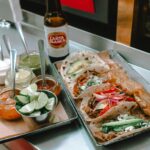This is just a preview of the insights available from CivicScience. Want to see how your brand stacks up against the competition? Get started.
While most Americans are familiar with Dry January, a month dedicated to abstaining from alcohol, a newer movement is gaining traction: Sober October. Much like its January counterpart, Sober October encourages participants to go alcohol-free for the entire month.
Although these alcohol-free challenges are temporary, CivicScience data reveal that they may be driving more permanent shifts in consumer behavior. From the rise of mocktails to the growing popularity of non-alcoholic beer, alcohol alternatives are becoming increasingly mainstream, suggesting that many are reconsidering their drinking habits well beyond these month-long events.
So, what can we expect this October, and how are alcohol-free movements reshaping America’s relationship with alcohol? Here’s what the data say, according to our database of over 5 billion consumer responses:
Sober October’s intended participation aligns with 2022 intent levels.
While intended participation is less than this year’s Dry January intent, a considerable percentage of drinking-aged Americans still plan to participate in Sober October. Currently, 10% of U.S. adults 21+ plan to participate, equivalent to two years ago. This figure jumps to 17% among Gen Z aged 21-24 and 16% among Millennials aged 25-44. Whereas, less than 10% of Americans 45+ plan to participate in Sober October.
Join the Conversation: Do you plan on participating in “Sober October” this year?
Budweiser has the highest percentage of Sober October participants.
Tapping into CivicScience’s database of over 500K crossable questions shows that among the three beer brands studied, Budweiser brand favorables are most likely to participate in Sober October (17%), followed by Miller Lite (14%) and Labatt Blue (14%). This could be a good time for these beer brands to advertise their non-alcoholic offerings, such as Budweiser Zero and Labatt Blue Non-Alc.

Gen Z is filling the void with non-alcoholic beverages, Millennials are filling it with cannabis.
When it comes to replacing alcoholic beverages this month, data show that non-alcoholic beverages, cannabis, and soda/seltzer products are nearly equally popular to fill the void among the Gen Pop. Gen Z participants aged 21-24 are most likely to fill the void in general, with non-alcoholic and alcohol-free beverages at the top and a high percentage subbing cannabis for alcohol. Millennials aged 25-44 are more likely to replace alcohol with cannabis than non-alcoholic beverages. Soda/seltzer is most popular among Gen X, and Baby Boomers are most likely not to replace alcohol with anything.

Interest in sober-curious lifestyles continues to grow.
At the same time, sober curiosity is growing in the United States. Currently, 40% of drinking-aged adults say they’re at least ‘somewhat’ curious about a sober lifestyle, up nine percentage points from 2022 and up 20 percentage points from 2020.

When CivicScience polled Dry January participants, the majority said they plan to further cut or reduce their alcohol consumption. Similarly, Sober October participants are also interested in a sober lifestyle – 43% say they’re ‘very curious’ and another 42% are at least ‘somewhat curious’ about a sober lifestyle.1
Answer our Poll: Have you ever tried taking a month-long break from alcohol?
Overall, Sober October is more than just a temporary trend; it’s part of a larger movement that reflects changing attitudes toward alcohol in the U.S. With participation holding steady, particularly among younger generations, and a growing interest in sober-curious lifestyles, it’s clear that many are rethinking their relationship with alcohol.
This is just a glimpse of CivicScience’s capabilities – we leverage insights like these to build highly-targeted ad campaigns, reach persuadable buyers, and drive better ad engagement. Want to learn how?
- 729 responses from 9/27/2024 to 9/30/2024 ↩︎








